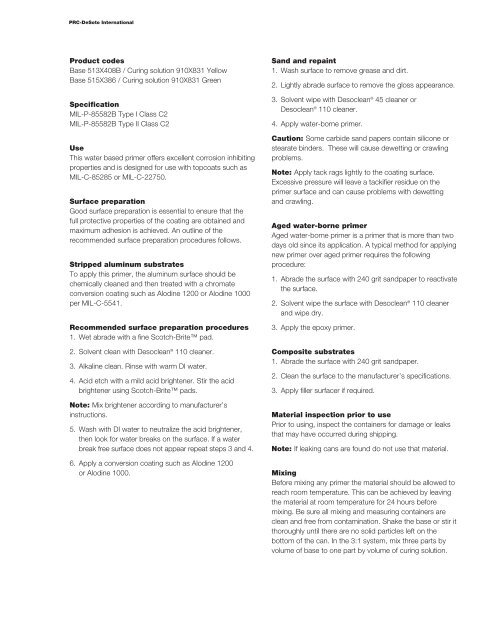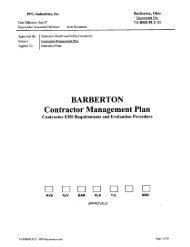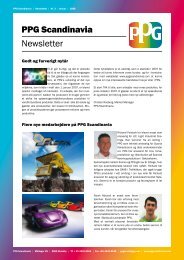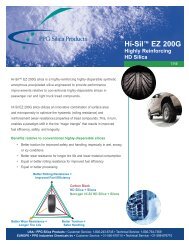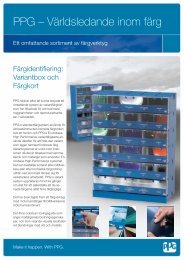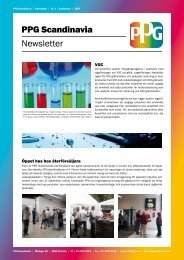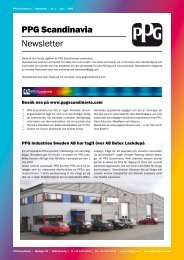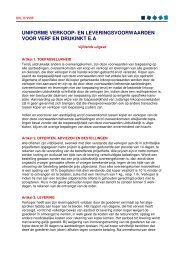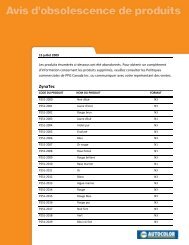513X408B - PPG Industries
513X408B - PPG Industries
513X408B - PPG Industries
You also want an ePaper? Increase the reach of your titles
YUMPU automatically turns print PDFs into web optimized ePapers that Google loves.
PRC-DeSoto International<br />
Product codes<br />
Base <strong>513X408B</strong> / Curing solution 910X831 Yellow<br />
Base 515X386 / Curing solution 910X831 Green<br />
Specification<br />
MIL-P-85582B Type I Class C2<br />
MIL-P-85582B Type II Class C2<br />
Use<br />
This water based primer offers excellent corrosion inhibiting<br />
properties and is designed for use with topcoats such as<br />
MIL-C-85285 or MIL-C-22750.<br />
Surface preparation<br />
Good surface preparation is essential to ensure that the<br />
full protective properties of the coating are obtained and<br />
maximum adhesion is achieved. An outline of the<br />
recommended surface preparation procedures follows.<br />
Stripped aluminum substrates<br />
To apply this primer, the aluminum surface should be<br />
chemically cleaned and then treated with a chromate<br />
conversion coating such as Alodine 1200 or Alodine 1000<br />
per MIL-C-5541.<br />
Recommended surface preparation procedures<br />
1. Wet abrade with a fine Scotch-Brite pad.<br />
2. Solvent clean with Desoclean ® 110 cleaner.<br />
3. Alkaline clean. Rinse with warm DI water.<br />
4. Acid etch with a mild acid brightener. Stir the acid<br />
brightener using Scotch-Brite pads.<br />
Note: Mix brightener according to manufacturer’s<br />
instructions.<br />
5. Wash with DI water to neutralize the acid brightener,<br />
then look for water breaks on the surface. If a water<br />
break free surface does not appear repeat steps 3 and 4.<br />
6. Apply a conversion coating such as Alodine 1200<br />
or Alodine 1000.<br />
2<br />
Sand and repaint<br />
1. Wash surface to remove grease and dirt.<br />
2. Lightly abrade surface to remove the gloss appearance.<br />
3. Solvent wipe with Desoclean ® 45 cleaner or<br />
Desoclean ® 110 cleaner.<br />
4. Apply water-borne primer.<br />
Caution: Some carbide sand papers contain silicone or<br />
stearate binders. These will cause dewetting or crawling<br />
problems.<br />
Note: Apply tack rags lightly to the coating surface.<br />
Excessive pressure will leave a tackifier residue on the<br />
primer surface and can cause problems with dewetting<br />
and crawling.<br />
Aged water-borne primer<br />
Aged water-borne primer is a primer that is more than two<br />
days old since its application. A typical method for applying<br />
new primer over aged primer requires the following<br />
procedure:<br />
1. Abrade the surface with 240 grit sandpaper to reactivate<br />
the surface.<br />
2. Solvent wipe the surface with Desoclean ® 110 cleaner<br />
and wipe dry.<br />
3. Apply the epoxy primer.<br />
Composite substrates<br />
1. Abrade the surface with 240 grit sandpaper.<br />
2. Clean the surface to the manufacturer’s specifications.<br />
3. Apply filler surfacer if required.<br />
Material inspection prior to use<br />
Prior to using, inspect the containers for damage or leaks<br />
that may have occurred during shipping.<br />
Note: If leaking cans are found do not use that material.<br />
Mixing<br />
Before mixing any primer the material should be allowed to<br />
reach room temperature. This can be achieved by leaving<br />
the material at room temperature for 24 hours before<br />
mixing. Be sure all mixing and measuring containers are<br />
clean and free from contamination. Shake the base or stir it<br />
thoroughly until there are no solid particles left on the<br />
bottom of the can. In the 3:1 system, mix three parts by<br />
volume of base to one part by volume of curing solution.


